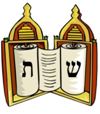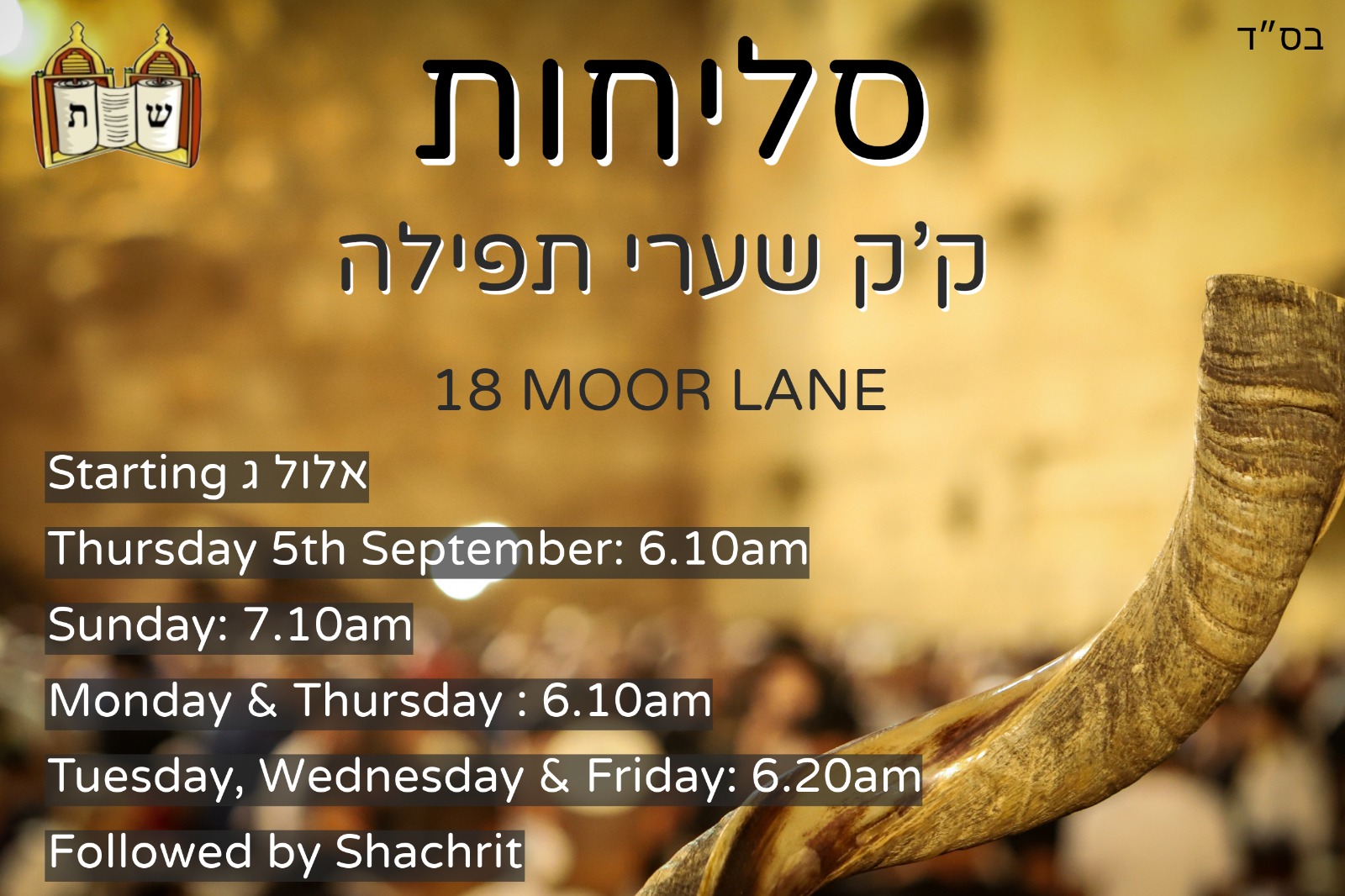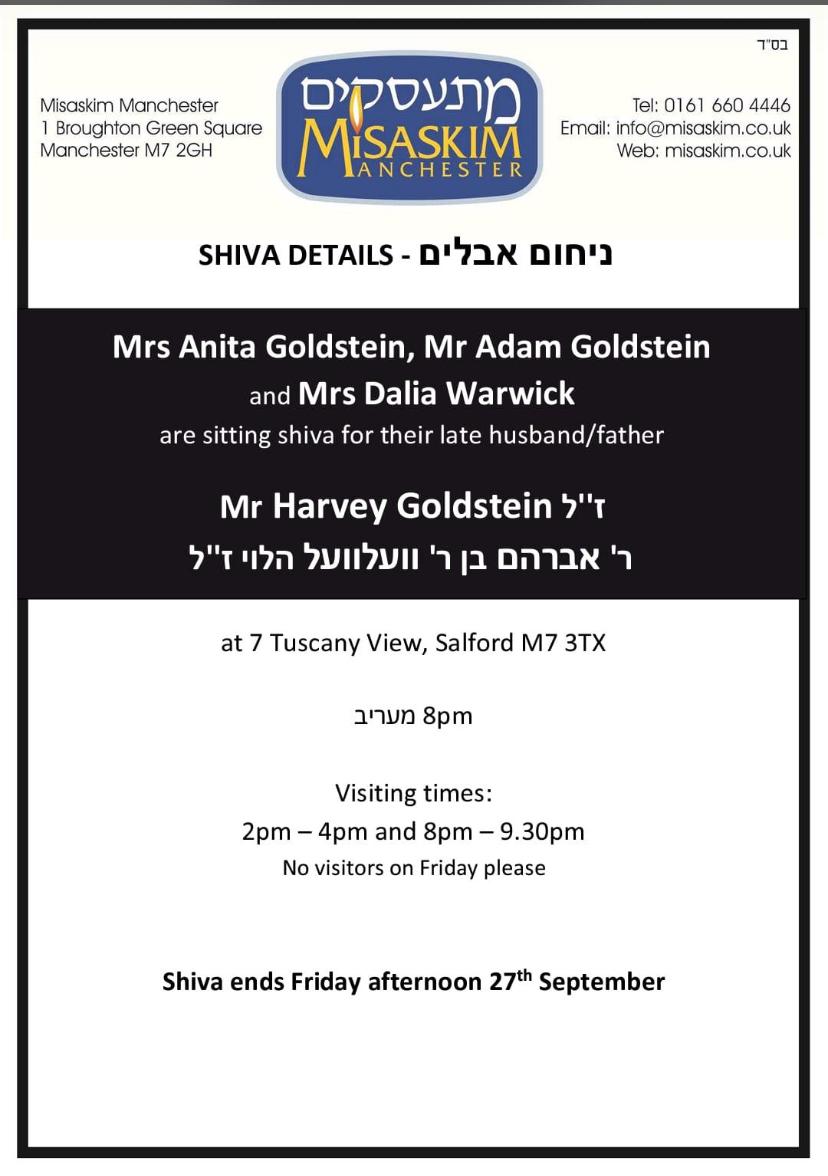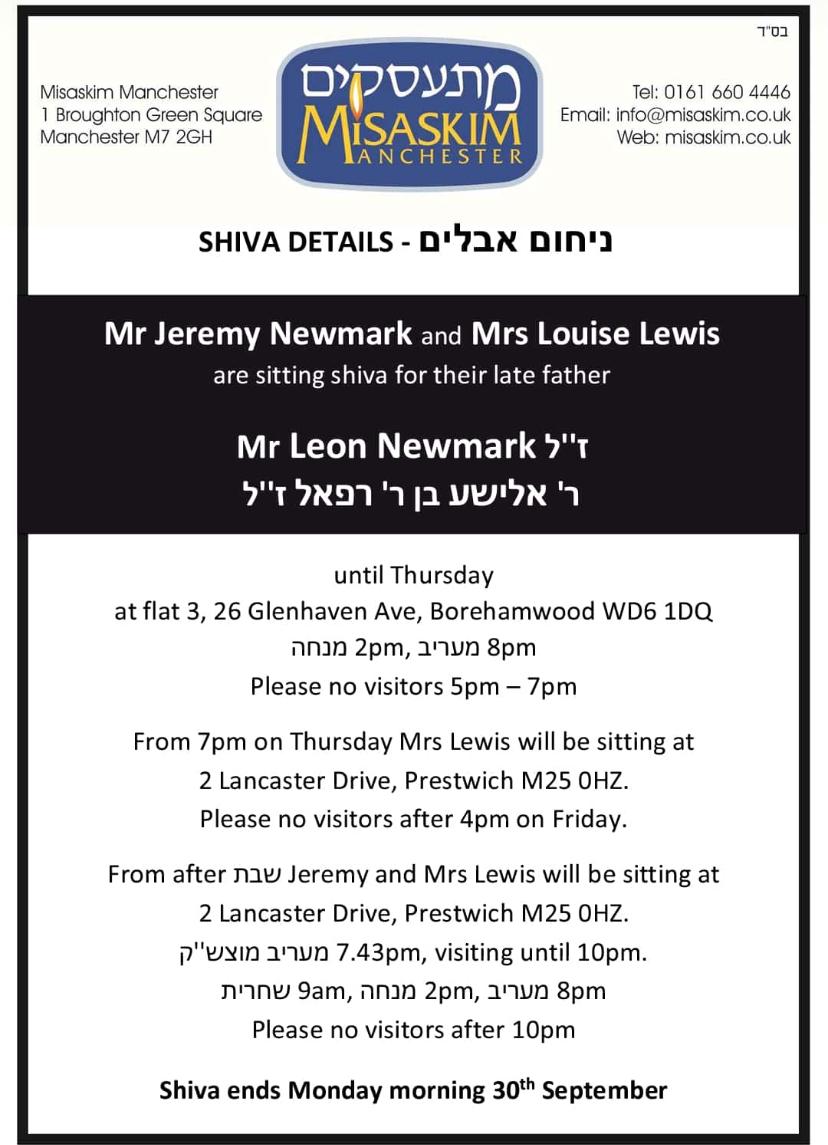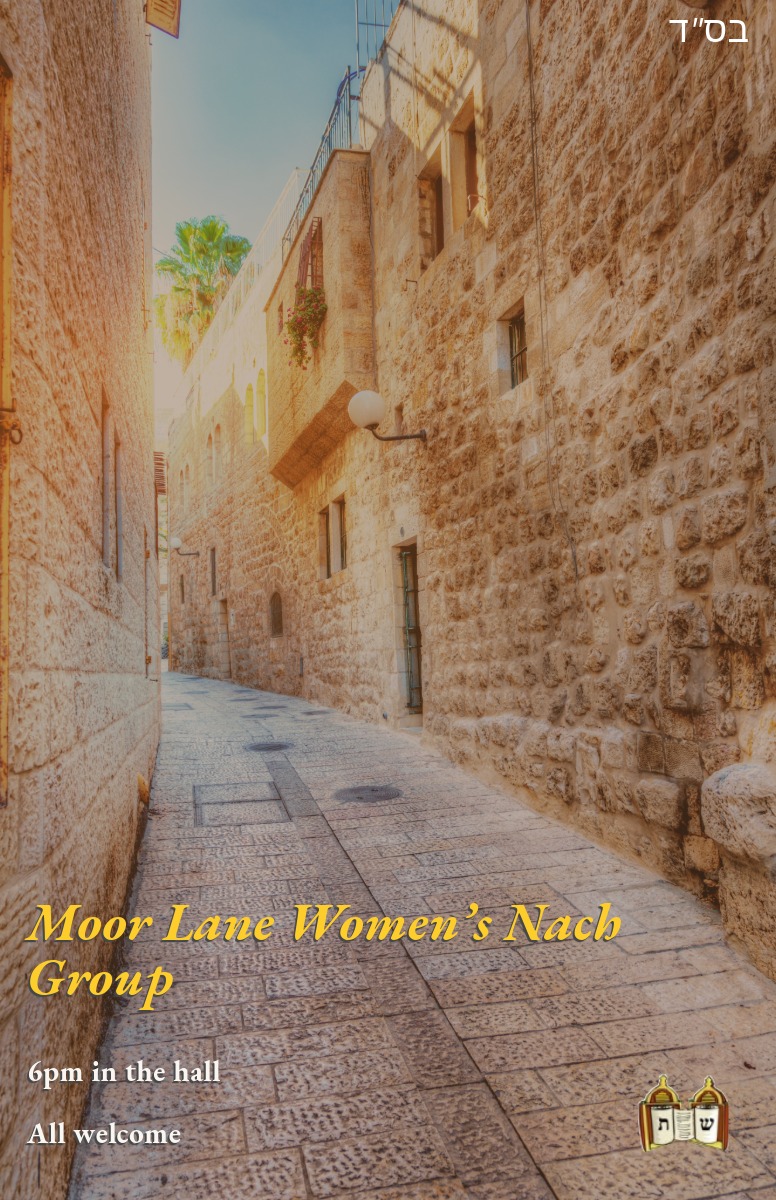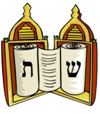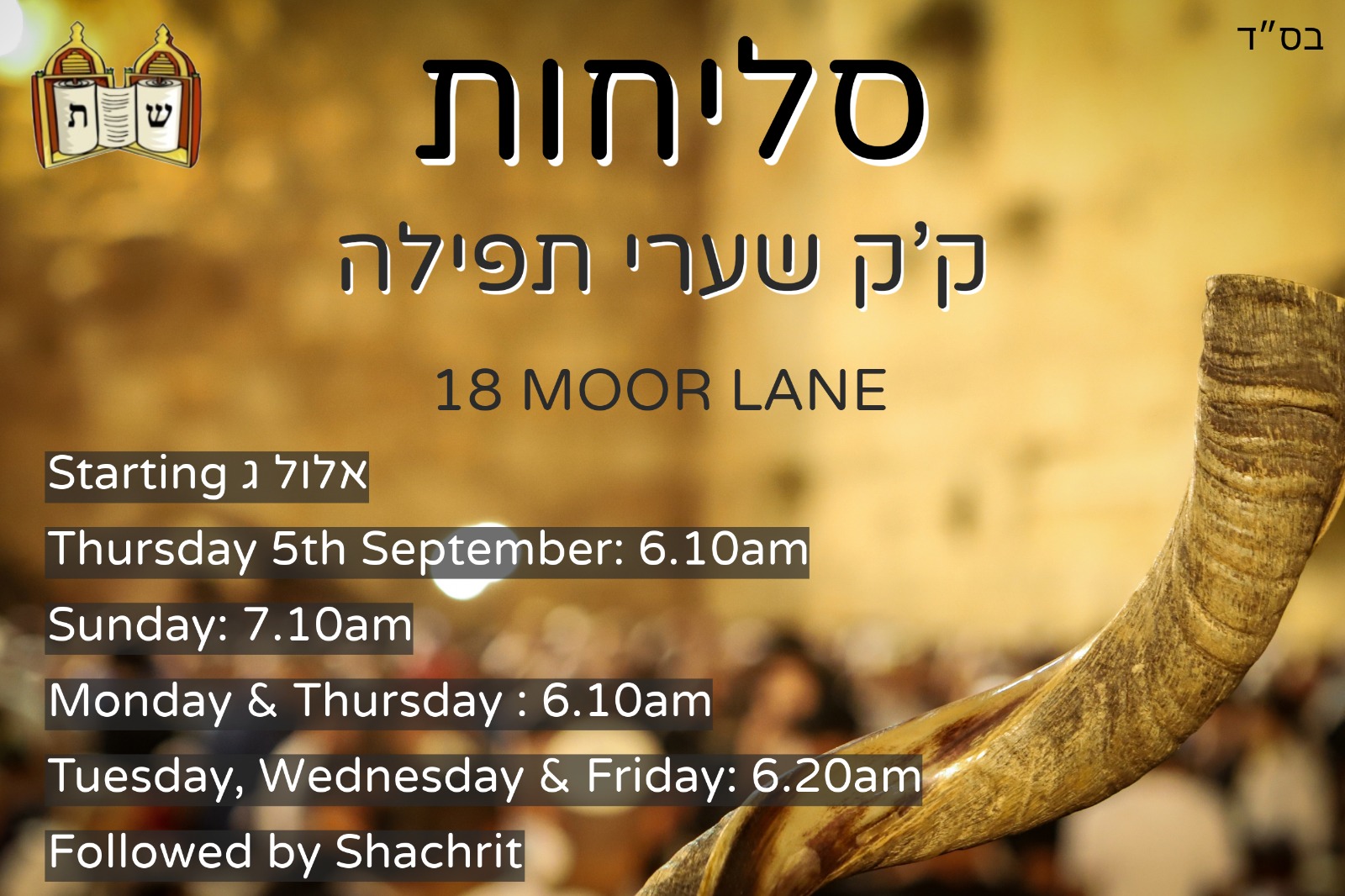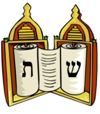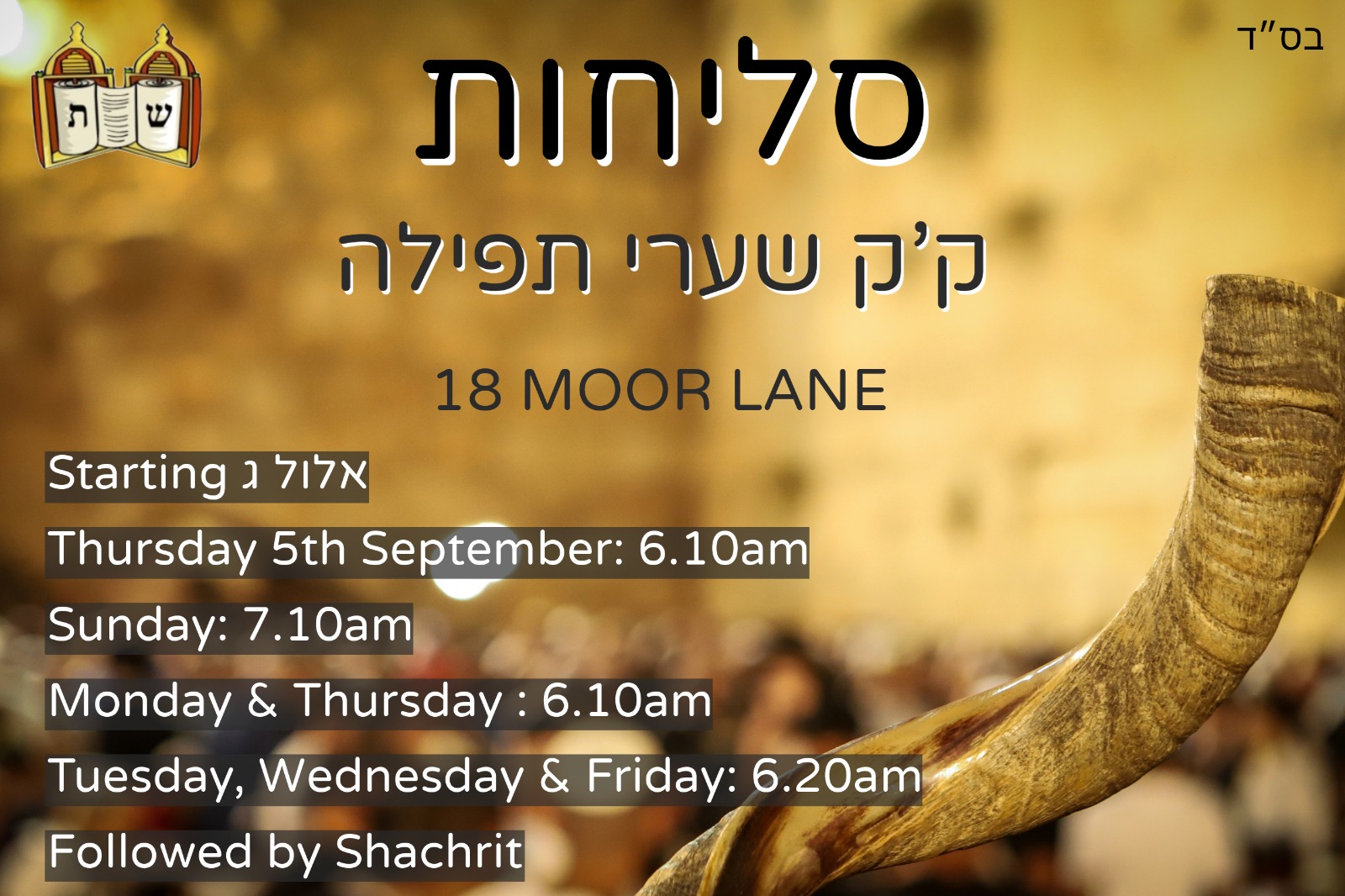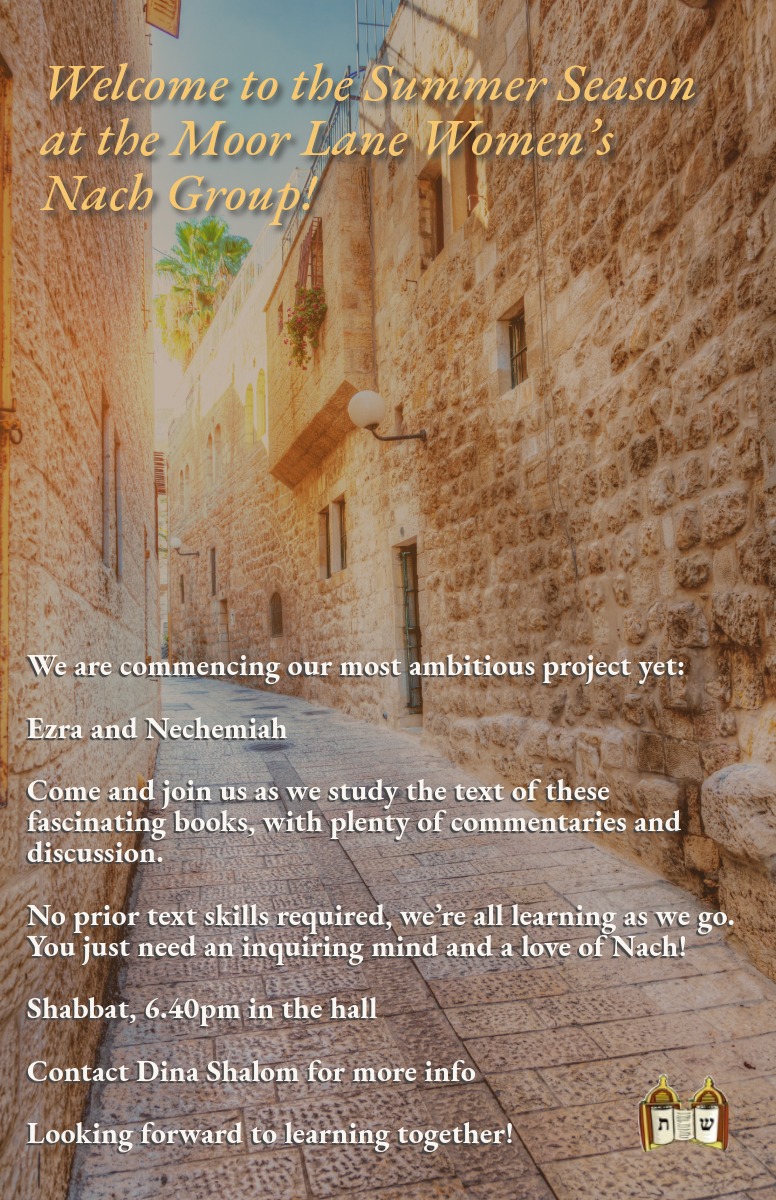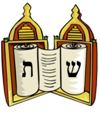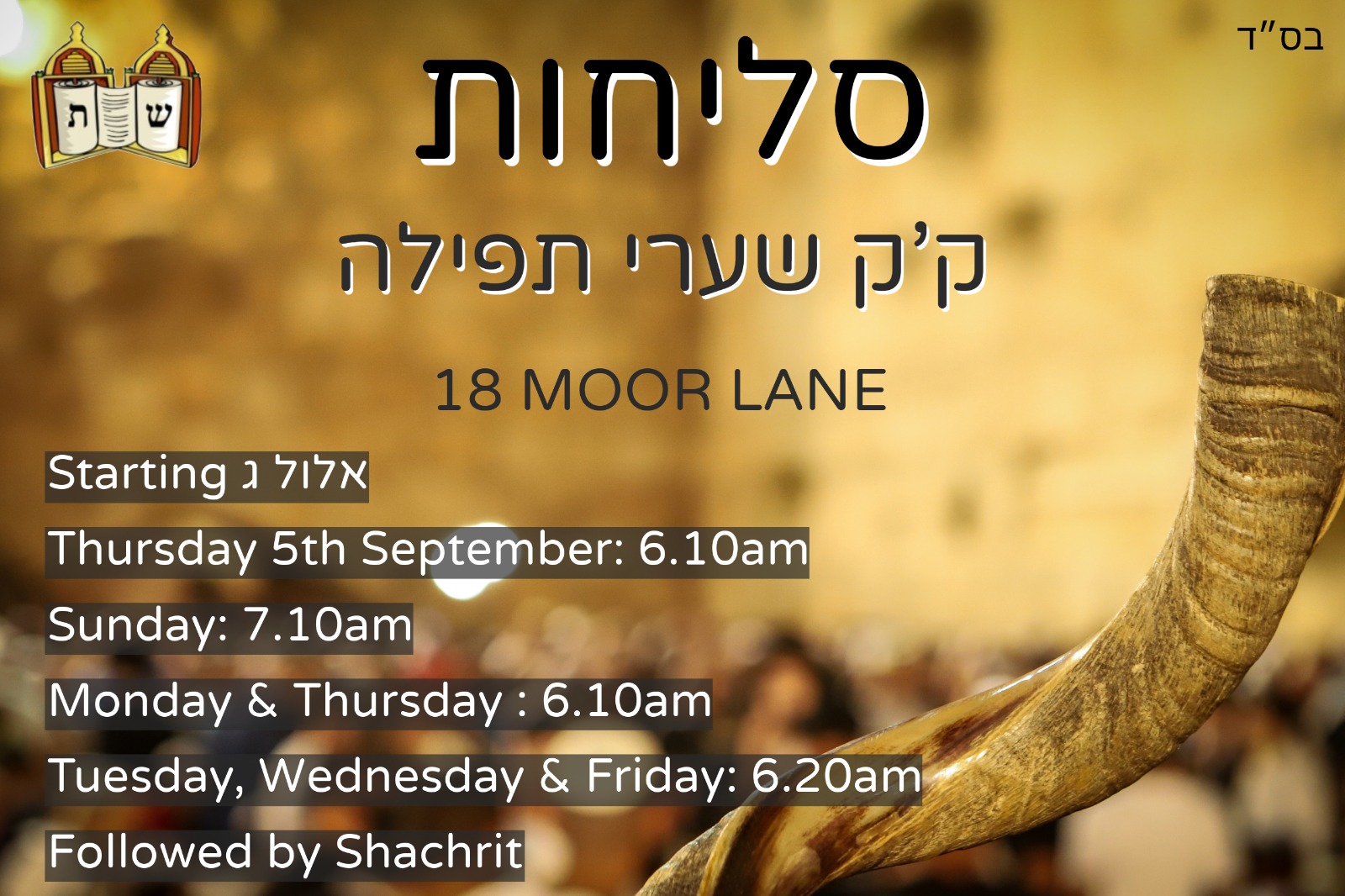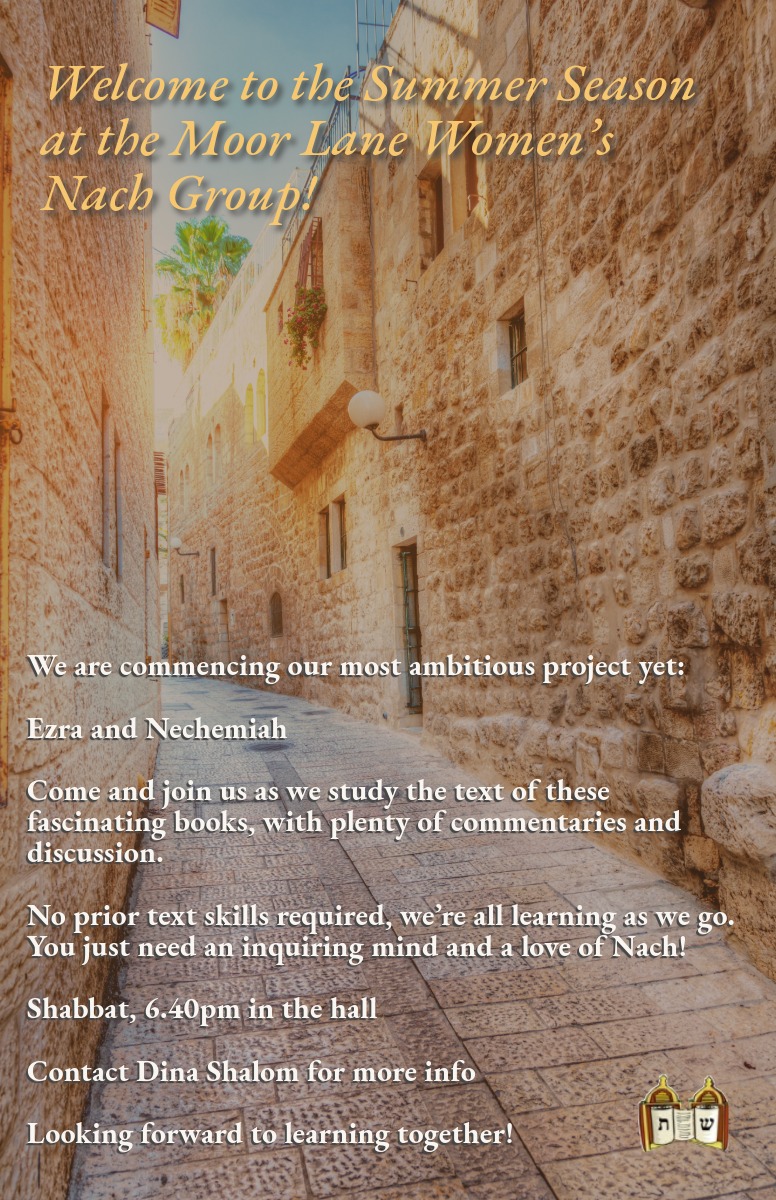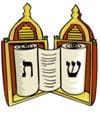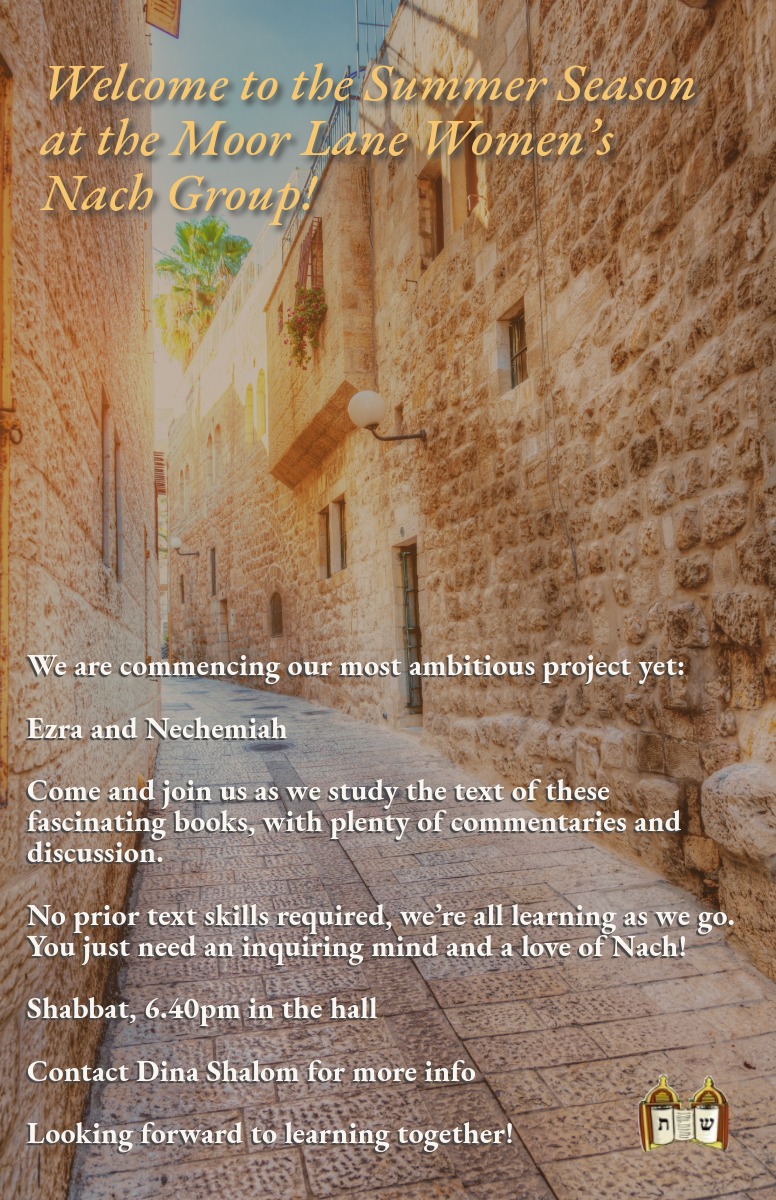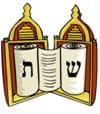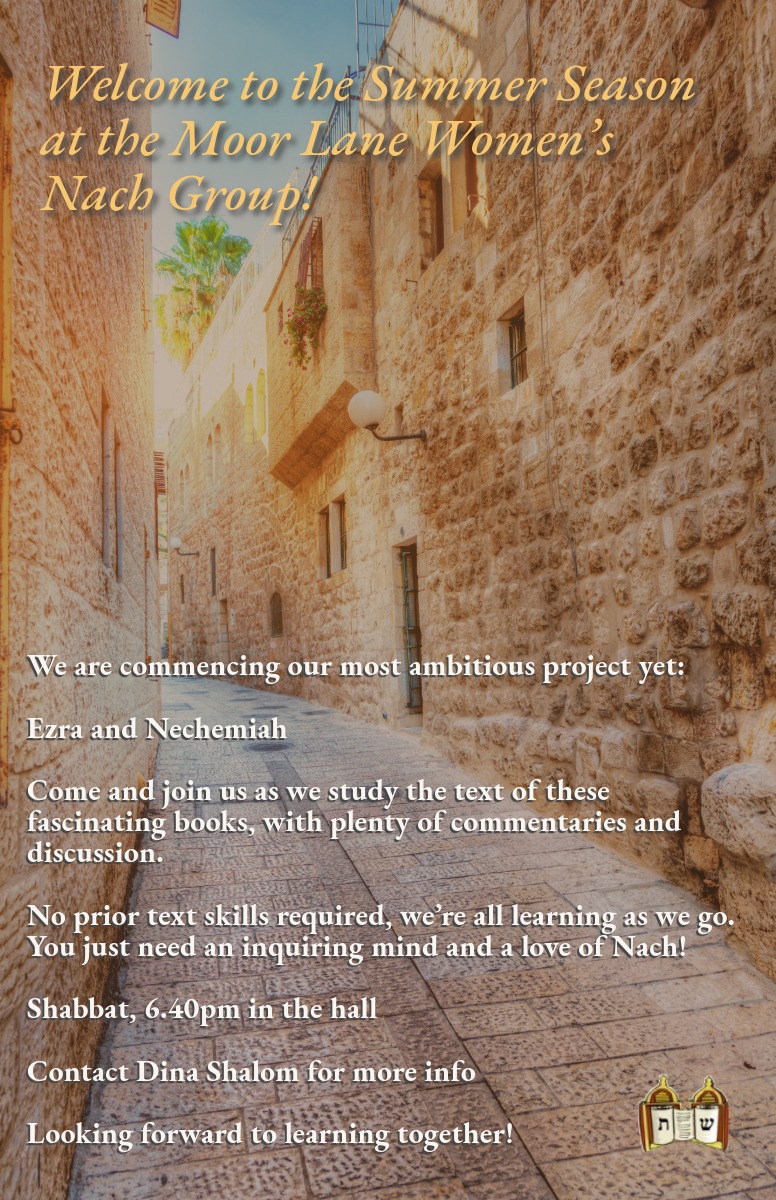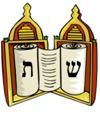
ק׳ ק׳ שׁערי תפילה

Wishing Members & Friends
of
ק׳ ק׳ שערי תפילה
Moor Lane Bet Hakeneset
a
כתיבה וחתימה טובה
תזכו לשנים רבות נעימות וטובות
שנה טובה ומתוקה
שנה עם בריאות ברכה מזל הצלחה פרנסה טובה
רפואה שלמה והצלה לכל עם ישראל

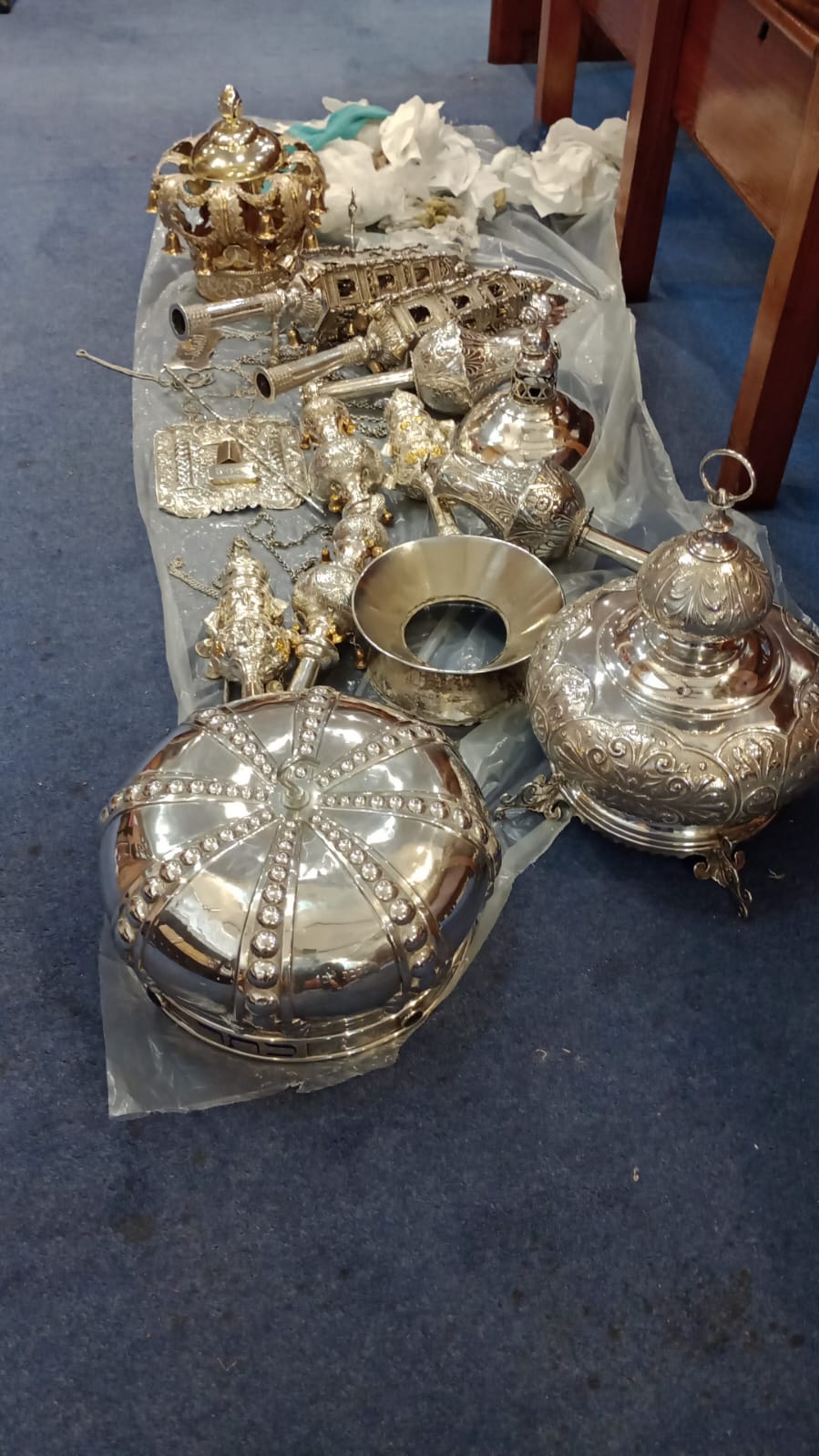








Pledge Reminder
There is a big segula to pay any debts before Rosh Hashana,
so we'd like to send a reminder that if you have made
a donation to the Bet Hakeneset
after receiving an Aliya in the last few weeks,
the donation can be fulfilled in any of the following ways:
· By post addressed to
'The Treasurer, Manchester Congregation of Spanish and Portuguese Jews,
18 Moor Lane, Salford, Manchester M7 3WX'.
· By hand to the treasurer or any member of the Mahamad.
·Anonymously in the donations box in the Synagogue.
·Direct Debit to the shul's account
for account details please speak to the treasurer
·Cheque
Cheques should be made payable to
'Manchester Congregation of Spanish & Portuguese Jews'.
Thank you & Tizke Lemitzvot
- Why do we blow the shofar during the month of Elul?
After the sin of the golden calf, Moshe went up to Mount Sinai to receive the second set of Tablets on Rosh Chodesh Elul. On that day, the Jewish People sounded the shofar to remind themselves to stray no more after idol worship. Also, the sound of the shofar strikes awe into our hearts and inspires us to return to the ways of Torah. (Mishna Berura and Aruch Hashulchan Orach Chaim 581) - Where in the written Torah text does it tell us explicitly that the first day of Tisrei is Rosh Hashanah?
Nowhere. The Torah calls it “a day of shofar blowing.” (This is one of many examples showing how our observance depends on the continuous oral tradition dating back to Mount Sinai). (Bamidbar 29:1) - We eat apples dipped in honey to symbolize a sweet year. Why do we choose apples above other sweet fruits?
Isaac blessed Jacob with the words: “The fragrance of my son is like the fragrance of a field which Hashem has blessed…” (Bereishis 27:27). The Talmud identifies this “field” as an apple orchard. (Ta'anis 29b, Biyur Hagra) - What two blessings do we say before sounding the shofar?
“Blessed are You… who has commanded us to hear the sound of the shofar,” and the shehechiyanu blessing. (Orach Chaim 581:2) - Which Book of Tanach does the beginning of the Tashlich prayer come from?
The Book of Micha (7:18-20). - What three barren women were “remembered” by Hashem on Rosh Hashanah?
Sara, Rachel and Chana. On Rosh Hashanah it was decreed that these barren women would bear children. (Tractate Rosh Hashanah 10b) - A person's yearly allowance is fixed on Rosh Hashanah, except for three types of expenses. What are they?
Expenses for Shabbos, Yom Tov, and the cost of one's children's Torah education. (Ba'er Hetaiv Orach Chaim 242:1) - We refer to the binding of Isaac in our prayers when we say: “Answer us as You answered Abraham our father on Mount Moriah…” What was Abraham's prayer on Mount Moriah?
He prayed that Mount Moriah should remain a place of prayer for all future generations (Onkelos 22:14). Also, he prayed that his sacrifice of the ram should be considered as though he had actually sacrificed Isaac. (Rashi 22:13) - Why, even in Israel, are there two days of Rosh Hashanah, whereas other festivals in Israel are celebrated for only one day?
Before our current exile, we did not have a fixed calendar as we do today. Rather, the Supreme Torah Court in Jerusalem determined our calendar on a month to month basis. They did this on the first day of every month, based on witnesses testifying that they had seen the new moon. Therefore, the people outside Israel had insufficient time to find out the exact date in time for the festivals. The “two-day festival” arose to correct this situation. In Israel, however, the people lived close enough to Jerusalem to find out the exact date of all the festivals except Rosh Hashanah. Since Rosh Hashanah occurs on the first day of the month, even those living in Jerusalem sometimes needed to observe it for two days, if the witnesses failed to arrive. - What halacha applies to the shehechiyanu blessing on the second night of Rosh Hashanah which does not apply on the second night of any other holiday?
On the second night of Rosh Hashanah it is customary to wear a new garment or to have a new fruit on the table when saying the shehechiyanu blessing. Thus, the shehechiyanu blessing applies not only to the holiday, but to the new garment or new fruit as well. (This is done in order to accommodate the minority of halachic authorities who rule that no shehechiyanu blessing be said on the second night of Rosh Hashanah.) (Taz 600:2)

תקיעת שופר
מצות עשה מן התורה לשמוע תרועת השופר ביום ראש השנה, שנאמר “יום תרועה יהיה לכם”. ואסור לדבר בין התקיעות, וכל שכן בזמן התקיעות עצמם, ומשעה שבירך “לשמוע קול שופר” (או שיצא ידי חובת הברכה מפי השליח ציבור), לא יוציא הגה מפיו עד שישמע את התקיעות.
נאמר בתורה שלוש פעמים “יום תרועה יהיה לכם”, “זכרון תרועה מקרא קודש”, “והעברת שופר תרועה”. וקיבלו רבותינו “הלכה למשה מסיני”, שכל התקיעות הללו אמורות לגבי ראש השנה, שיש לתקוע בו שלוש פעמים.
וכל תרועה שצריך לתקוע, מורכבת משלוש תקיעות. תקיעה, תרועה ותקיעה. כי כל תרועה, צריך שיהיו לפניה ולאחריה קולות של תקיעה פשוטה. שכך למדו רבותינו מן הפסוקים. נמצאנו למדים, שעלינו לתקוע שלוש תרועות, ולפני ולאחרי כל אחת מהן, יש לתקוע תקיעה פשוטה. ובסך הכל: תקיעה תרועה תקיעה, תקיעה תרועה תקיעה, תקיעה תרועה תקיעה. שהן תשעה קולות של שופר.
התקיעה שנאמרה בתורה, היא קול תקיעה חלקה, ישרה ורצופה. אולם לגבי התרועה שנאמרה בתורה, יש בידינו ספק מה היא. מפני שחלפו הרבה שנים, ונתפזרו עם ישראל בגלות, ותקיעת שופר היא דבר שמתרחש רק פעם אחת בשנה, ולכן אין אנו יודעים איך התרועה נשמעת, האם היא היללה שמיללות הנשים בשעה שמייבבות, והן קולות קצרים ביותר ורצופים (מה שאנו קוראים בזמן הזה “תרועה”), או שהתרועה היא האנחה כדרך שנאנח אדם פעם אחר פעם כאשר דואג לבו מדבר גדול (כלומר, שלוש פעמים תו תו תו, מה שאנו קוראים “שברים”). או אולי, התרועה שנאמרה בתורה היא שניהם יחד, גם קול היללה וגם קול השברים.
ומחמת הספק, אנו עושים הכל. נמצא שסדר התקיעות כך הוא: התוקע מברך, ומיד תוקע “תקיעה” ולאחריה שלושה “שברים” ואחריהם “תרועה” ואחריה “תקיעה”. וחוזר על סדר זה שלוש פעמים. ותוקע “תקיעה”, ואחריה שלושה “שברים” ואחריהם “תקיעה”, וחוזר על סדר זה שלוש פעמים. ותוקע “תקיעה” ואחריה “תרועה” ואחריה “תקיעה”, וחוזר על סדר זה שלוש פעמים. נמצא מנין התקיעות שלושים, כדי להסתלק מן הספק. (ראש השנה לד. והרמב”ם פ”ג ה”א ומרן בש”ע סימן תקצ).
והוא מה שאנו רואים במחזורים: תשר”ת תשר”ת תשר”ת, כלומר תקיעה שברים תרועה תקיעה – שלוש פעמים. ואחר כך, תש”ת תש”ת תש”ת, כלומר תקיעה שברים תקיעה – שלוש פעמים. ואחר כך תר”ת תר”ת תר”ת, והוא תקיעה תרועה תקיעה – שלוש פעמים.
ורמז לדבר “יום תרועה יהיה לכם”, “יהיה” בגימטריא שלושים.
ואלו התקיעות הן חובה מעיקר הדין. ומלבד זה תוקעים עוד שלושים תקיעות בחזרת השליח ציבור של מוסף. ולאחר מכן בסיום התפלה.
Shofar Blowing
There is a positive Torah commandment to hear the Shofar blasts on Rosh Hashanah, as the Torah states, “A day of blasts shall it be for you.” It is forbidden to speak between the various sets of Shofar blasts and this is certainly the case during the time the Shofar is actually being sounded. As soon as one recites the blessing of “Lishmo’a Kol Shofar” (or has fulfilled one’s obligation by hearing the Shofar blower recite it), one should not utter anything until one hears the Shofar blasts.
How Many Blasts Must One Hear?
According to the Torah, it is sufficient to hear nine Shofar blasts on Rosh Hashanah. Let us now discuss this further:
The Torah states “blasts” in three different contexts: “A days of blasts shall it be for you”, “A memorial of blasts, a convocation of holiness”, and “And you shall make a proclamation with the Shofar blasts”. Our Sages had an oral tradition from Moshe Rabbeinu that all of these blasts apply to Rosh Hashanah and one must sound three blasts on that day.
Every sounding of Shofar blasts on Rosh Hashanah must be comprised of three separate blasts: Teki’ah, Teru’ah, Teki’ah. This is because or Sages derived from various verses in the Torah that every Teru’ah sound must be preceded and followed by a Teki’ah sound. Thus, we must blow three Teru’ah blasts, each of them preceded and followed by a Teki’ah blast, amounting to three sets of Teki’ah, Teru’ah, Teki’ah, i.e. nine blasts.
Why Do We Blow Many More than Nine Shofar Blasts?
Based on the above, one should only be required to hear three sets of Teki’ah, Teru’ah, Teki’ah on Rosh Hashanah. However, this is not what is practiced, as we shall now explain:
The Teki’ah described by the Torah refers to a flat, straight, continuous Shofar blast. Nevertheless, a doubt exists regarding what the Torah describes as a “Teru’ah” because many years have passed and the Jewish nation has been scattered in the diaspora as a result of several long exiles. Thus, we are unsure whether Teru’ah refers to a wailing sound that women make when crying, i.e. very short, continuous sounds blown one after another (what we refer to as “Teru’ah” nowadays) or a longer sighing sound one would make again and again when worried about something important (three times, what we would call “Shevarim” nowadays). It is likewise possible that the Torah-prescribed “Teru’ah” actually refers to a combination of both sounds, sighing and wailing.
Because of this is vested in doubt, we blow all of these. Thus, the proper order of blowing the Shofar is, as follows: After reciting the blessing, the Shofar-blower blows a Teki’ah, followed by a Shevarim, immediately followed by a Teru’ah, followed by a Teki’ah. This order is repeated three times. After a brief pause, the blower then blows a Teki’ah, followed by a Shevarim, followed by a Teki’ah. This order is likewise repeated three times. After another short pause, the blower resumes by blowing a Teki’ah, followed by a Teru’ah, followed by a Teki’ah. This order is likewise repeated three times. The final order of Shofar blasts necessary in order to remove all doubt is therefore thirty. (See Rosh Hashanah 34a, Rambam Hilchot Shofar, Chapter 3, Halachot 1-3, and Shulchan Aruch, Chapter 590, Sections 1-2.)
These Shofar blasts are obligatory according to the letter of the law. Besides for these, thirty more blasts are blown during the silent Mussaf Amida prayer, another thirty during the Chazzan’s repetition of Mussaf, and a final ten within the Kaddish following Mussaf.
